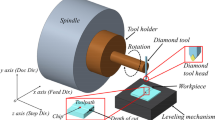Abstract
Increasing interest in commercializing functional nanostructured devices heightens the need for cost-effective manufacturing approaches for nanostructures. This paper presents an investigation of a scale-up manufacturing approach for nanostructures through diamond turning using a nanoscale multi-tip diamond tool (four tip tool with tip width of 150 nm) fabricated by focused ion beam (FIB). The manufacturing capacity of this new technique is evaluated through a series of cutting trials on copper substrates under different cutting conditions (depth of cut 100–500 nm, spindle speed 12–120 rpm). The machined surface roughness and nanostructure patterns are measured by using a white light interferometer and a scanning electron microscope, respectively. Results show that the form accuracy and integrity of the machined nanostructures were degraded with the increase of the depth of cut and the cutting speed. The burr and the structure damage are two major machining defects. High precision nano-grooves (form error of bottom width < 6.7 %) was achieved when a small depth of cut of 100 nm was used (spindle speed = 12 rpm). Initial tool wear was found at both the clearance cutting edge and the side edges of tool tips after a cutting distance of 2.5 km. Moreover, the nanometric cutting process was emulated by molecular dynamic (MD) simulations. The research findings obtained from MD simulation reveal the underlying mechanism for machining defects and the initialization of tool wear observed in experiments.
Similar content being viewed by others
References
Holmberg S, Perebikovsky A, Kulinsky L, Madou M (2014) 3-D micro and nano technologies for improvements in electrochemical power devices. Micromachines 5:171–203
Bartolo P, Kruth J-P, Silva J, Levy G, Malshe A, Rajurkar K et al (2012) Biomedical production of implants by additive electro-chemical and physical processes. CIRP Ann Manuf Technol 61:635–655
Berman D, Krim J (2013) Surface science, MEMS and NEMS: progress and opportunities for surface science research performed on, or by, microdevices. Prog Surf Sci 88:171–211
Picard YN, Adams D, Vasile M, Ritchey M (2003) Focused ion beam-shaped microtools for ultra-precision machining of cylindrical components. Precis Eng 27:59–69
Ding X, Lim G, Cheng C, Butler DL, Shaw K, Liu K et al (2008) Fabrication of a micro-size diamond tool using a focused ion beam. J Micromech Microeng 18:075017
Xu Z, Fang F, Zhang S, Zhang X, Hu X, Fu Y et al (2010) Fabrication of micro DOE using micro tools shaped with focused ion beam. Opt Express 18:8025–8032
Sun J, Luo X, Chang W, Ritchie J, Chien J, Lee A (2012) Fabrication of periodic nanostructures by single-point diamond turning with focused ion beam built tool tips. J Micromech Microeng 22:115014
Luo X, Tong Z, Liang Y (2014) Investigation of the shape transferability of nanoscale multi-tip diamond tools in the diamond turning of nanostructures. Appl Surf Sci 321:495–502
Yan Y, Sun T, Dong S, Liang Y (2007) Study on effects of the feed on AFM-based nano-scratching process using MD simulation. Comput Mater Sci 40:1–5
Ye Y, Biswas R, Morris J, Bastawros A, Chandra A (2003) Molecular dynamics simulation of nanoscale machining of copper. Nanotechnology 14:390
Zhu P-z, Hu Y-z, Ma T-b, Wang H (2010) Study of AFM-based nanometric cutting process using molecular dynamics. Appl Surf Sci 256:7160–7165
Lin Z-C, Huang J-C (2008) A study of the estimation method of the cutting force for a conical tool under nanoscale depth of cut by molecular dynamics. Nanotechnology 19:115701
Cheng K, Luo X, Ward R, Holt R (2003) Modeling and simulation of the tool wear in nanometric cutting. Wear 255:1427–1432
Tong Z, Liang Y, Jiang X, Luo X (2014) An atomistic investigation on the mechanism of machining nanostructures when using single tip and multi-tip diamond tools. Appl Surf Sci 290:458–465
Tong Z, Liang Y, Yang X, Luo X (2014) Investigation on the thermal effects during nanometric cutting process while using nanoscale diamond tools. Int J Adv Manuf Technol 1–10
Sun X, Cheng K (2010) Multi-scale simulation of the nano-metric cutting process. Int J Adv Manuf Technol 47:891–901
Sun J, Luo X (2013) Deterministic fabrication of micro-and nanostructures by focused ion beam. Springer
Daw MS, Foiles SM, Baskes MI (1993) The embedded-atom method: a review of theory and applications. Mater Sci Rep 9:251–310
Tersoff J (1988) New empirical approach for the structure and energy of covalent systems. Phys Rev B 37:6991
Tersoff J (1989) Modeling solid-state chemistry: interatomic potentials for multicomponent systems. Phys Rev B 39:5566
Ikawa N, Shimada S, Tanaka H, Ohmori G (1991) An atomistic analysis of nanometric chip removal as affected by tool-work interaction in diamond turning. CIRP Ann Manuf Technol 40:551–554
Plimpton S (1995) Fast parallel algorithms for short-range molecular dynamics. J Comput Phys 117:1–19
Kelchner CL, Plimpton S, Hamilton J (1998) Dislocation nucleation and defect structure during surface indentation. Phys Rev B 58:11085
Hiromu N (1994) Principles of precision engineering. Oxford University Press, Oxford, pp 191–195
Kawasegi N, Niwata T, Morita N, Nishimura K, Sasaoka H (2014) Improving machining performance of single-crystal diamond tools irradiated by a focused ion beam. Precis Eng 38:174–182
Ikawa N, Donaldson R, Komanduri R, König W, McKeown P, Moriwaki T et al (1991) Ultraprecision metal cutting—the past, the present and the future. CIRP Ann Manuf Technol 40:587–594
Author information
Authors and Affiliations
Corresponding author
Rights and permissions
About this article
Cite this article
Tong, Z., Luo, X., Sun, J. et al. Investigation of a scale-up manufacturing approach for nanostructures by using a nanoscale multi-tip diamond tool. Int J Adv Manuf Technol 80, 699–710 (2015). https://doi.org/10.1007/s00170-015-7051-0
Received:
Accepted:
Published:
Issue Date:
DOI: https://doi.org/10.1007/s00170-015-7051-0




